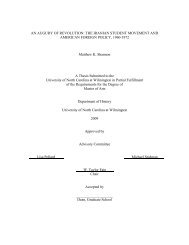Saprolegnia - The iLumina Digital Library
Saprolegnia - The iLumina Digital Library
Saprolegnia - The iLumina Digital Library
You also want an ePaper? Increase the reach of your titles
YUMPU automatically turns print PDFs into web optimized ePapers that Google loves.
CONFIRMED RECORD: -- BRITISH ISLES: Dick (loc. cit.).<br />
RECORDED COLLECTION: -- BRITISH ISLES: Dick (1966, pro parte).<br />
SPECIMENS EXAMINED: -- NORWAY (1), TWJ. MWD (3).<br />
<strong>Saprolegnia</strong> australis Elliott<br />
New Zealand J. Bot. 6:103, figs. 2, 4 c-f. 1968<br />
(Figure 93 A-E)<br />
Monoecious. Mycelium dense, diffuse; hyphae slender or stout. Sporangia<br />
cylindrical or clavate; renewed internally or cymosely; primary ones 20-460 x 15-33 µm;<br />
secondary ones usually shorter, but up to 600 µm long. Spores dimorphic; discharge<br />
and behavior generally saprolegnoid, occasionally dictyucoid; primary spore cysts 10.5-<br />
11.7 µm in diameter. Gemmae sparse or abundant; cylindrical, clavate, spherical, or<br />
irregular; terminal or intercalary, usually single. Oogonia generally terminal,<br />
occasionally lateral or intercalary, sometimes sessile; obovate, obpyriform, spherical, or<br />
napiform, sometimes slightly irregular, fusiform or dolioform when intercalary;<br />
(35-) 59-80 (-121) µm in diameter. Oogonial wall pitted, smooth. Oogonial stalks<br />
generally ( 1 / 3 -) 1-3 (-4) times the diameter of the oogonium, in length; straight, curved,<br />
twisted, or irregular; unbranched. Oospores may or may not mature, or may abort;<br />
when mature, subcentric; spherical to subspherical; (1-) 4-12 (-32) per oogonium, but<br />
usually not filling it; (10-) 22-27 (-36) µm in diameter; germination not observed.<br />
Antheridial branches, when present, predominantly diclinous, occasionally or rarely,<br />
monoclinous or androgynous; persisting or deliquescing; sparingly to moderately<br />
branched; usually slightly irregular, sometimes conspicuously contorted. Antheridial<br />
cells simple or branched, persisting; tubular or attached in a digitate fashion;<br />
fertilization tubes present or absent, not persisting.<br />
Until the report by Padgett (1976) of the recovery of specimens from eastern<br />
North Carolina, <strong>Saprolegnia</strong> australis was known only from the type locality. <strong>Saprolegnia</strong><br />
australis appears to be most variable with respect to sporangium size and the<br />
predominating oospore number and diameter (Padgett, 1976: Table 1; Nolan and<br />
Maestres, 1978: Table 1).<br />
<strong>The</strong> oospores of <strong>Saprolegnia</strong> australis are subcentric with the refractive droplets<br />
surrounding the ooplasm (Fig. 93 B) or only partially so (Fig. 93 E); such oospores are<br />
referred to by T. W. Johnson (1956b) and Seymour (1970) as types I and III, and both<br />
types can occur in the same oogonium. <strong>The</strong> oospheres of S. australis may or may not<br />
mature, or the oospores may develop and then abort (Fig. 93 A, C, D). In any event,<br />
nearly all oogonia contain at least a few disintegrated cells or imperfectly formed<br />
oospheres. Budding of oospheres -- resulting in small, spherical cells -- has been<br />
reported (Padgett, 1976).<br />
<strong>The</strong> preponderance of diclinous antheridial branches in <strong>Saprolegnia</strong> australis<br />
recalls a like condition in S. diclina. <strong>The</strong> oospheres of the latter generally mature,<br />
however, yet it must be recognized that some of the “parasitica-like” forms of S. diclina<br />
609
















